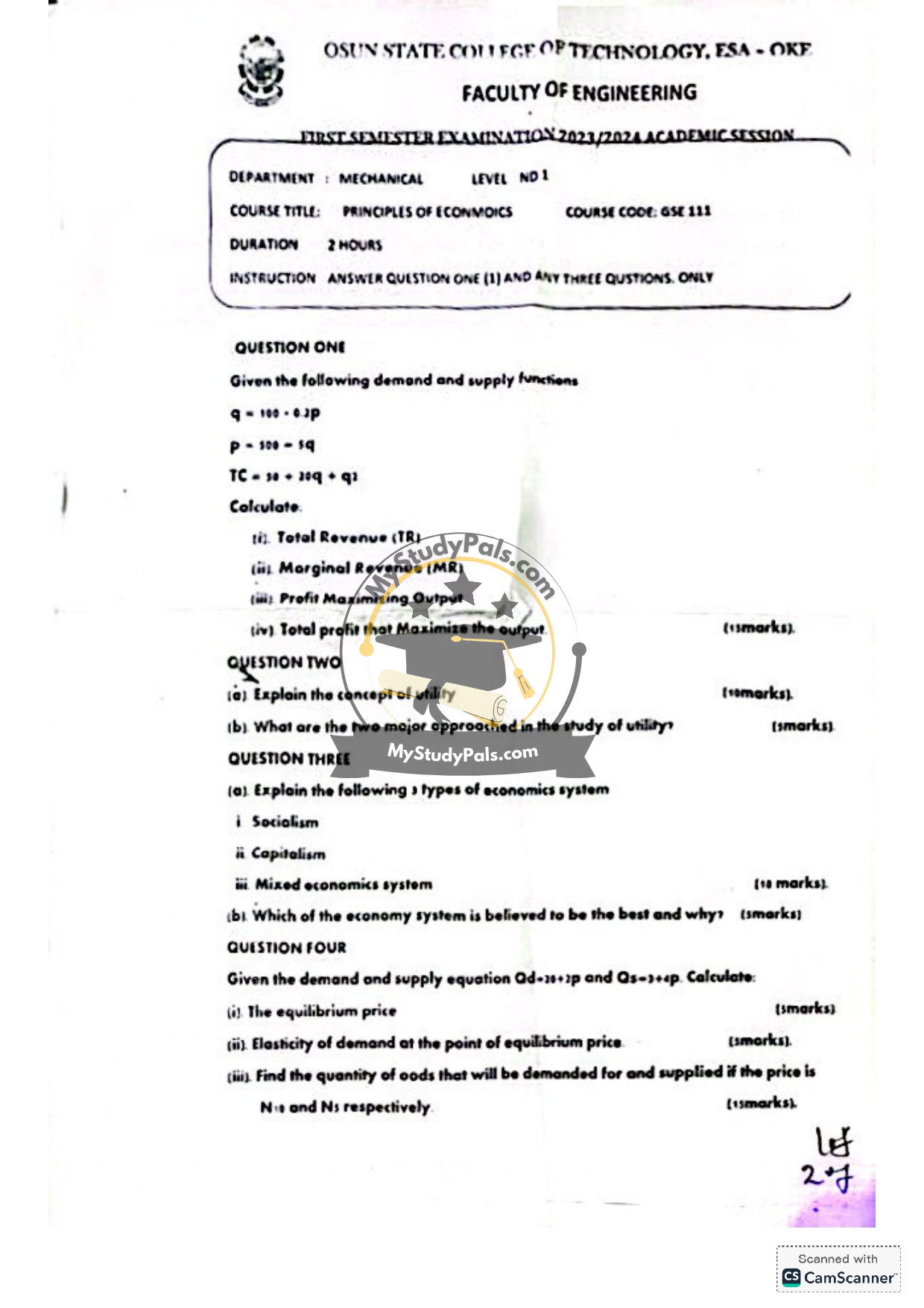ANWSER
Question 1:
Given:
- Demand function: q=100−0.2pq = 100 – 0.2p
- Inverse demand function: p=500−5qp = 500 – 5q
- Total Cost (TC): TC=30+20q+q2TC = 30 + 20q + q^2
(i) Total Revenue (TR):
TR = P × Q
Substitute p=500−5qp = 500 – 5q:
TR=(500−5q)q=500q−5q2TR = (500 – 5q)q = 500q – 5q^2
(ii) Marginal Revenue (MR):
MR = d(TR)/dq
MR=ddq(500q−5q2)=500−10qMR = \frac{d}{dq}(500q – 5q^2) = 500 – 10q
(iii) Profit Maximizing Output:
Profit is maximized where MR = MC.
First, find MC = d(TC)/dq:
MC=ddq(30+20q+q2)=20+2qMC = \frac{d}{dq}(30 + 20q + q^2) = 20 + 2q
Set MR = MC:
500−10q=20+2q⇒500−20=10q+2q⇒480=12q⇒q=40500 – 10q = 20 + 2q \Rightarrow 500 – 20 = 10q + 2q \Rightarrow 480 = 12q \Rightarrow q = 40
(iv) Total Profit that Maximizes Output:
Find TR and TC at q=40q = 40
- TR = 500(40)−5(40)2=20000−8000=12000500(40) – 5(40)^2 = 20000 – 8000 = 12000
- TC = 30+20(40)+402=30+800+1600=243030 + 20(40) + 40^2 = 30 + 800 + 1600 = 2430
- Profit = TR – TC = 12000−2430=957012000 – 2430 = 9570
Question 2:
(a) Explain the concept of utility:
Utility refers to the satisfaction or pleasure a consumer derives from consuming goods or services. It measures the usefulness or value that a consumer places on a good or service.
(b) What are the two major approaches in the study of utility?
- Cardinal Approach: Assumes utility can be measured in numerical units (utils).
- Ordinal Approach: Assumes utility cannot be measured but can be ranked or ordered based on preferences.
Question 3:
(a) Explain the following 3 types of economic systems:
i. Socialism:
An economic system where the government owns and controls the means of production. Resources are allocated based on centralized planning.
ii. Capitalism:
An economic system based on private ownership and free market principles. Prices and production are determined by supply and demand with minimal government interference.
iii. Mixed Economic System:
Combines elements of both capitalism and socialism. Both the private sector and the government play significant roles in economic decision-making.
(b) Which of the economy systems is believed to be the best and why?
The mixed economy is often considered the best because it balances the efficiency and innovation of the private sector with the social welfare goals of the public sector. It helps reduce inequalities and ensures basic services are accessible to all.
Question 4:
Given:
- Demand: Qd=220−2PQ_d = 220 – 2P
- Supply: Qs=−30+4PQ_s = -30 + 4P
(i) Equilibrium Price:
At equilibrium, Qd=QsQ_d = Q_s:
220−2P=−30+4P⇒220+30=6P⇒250=6P⇒P=2506≈41.67220 – 2P = -30 + 4P \Rightarrow 220 + 30 = 6P \Rightarrow 250 = 6P \Rightarrow P = \frac{250}{6} \approx 41.67
(ii) Elasticity of demand at equilibrium price:
Price elasticity of demand (Ed) = dQdP×PQ\frac{dQ}{dP} \times \frac{P}{Q}
From demand: Qd=220−2P⇒dQdP=−2Q_d = 220 – 2P \Rightarrow \frac{dQ}{dP} = -2
At P=41.67P = 41.67, Q=220−2(41.67)=220−83.33=136.67Q = 220 – 2(41.67) = 220 – 83.33 = 136.67
Ed=−2×41.67136.67≈−0.61E_d = -2 \times \frac{41.67}{136.67} \approx -0.61
(Inelastic demand)
(iii) Find the quantity of goods that will be demanded and supplied if price is:
- N10:
- Qd=220−2(10)=200Q_d = 220 – 2(10) = 200
- Qs=−30+4(10)=10Q_s = -30 + 4(10) = 10
- N55:
- Qd=220−2(55)=110Q_d = 220 – 2(55) = 110
- Qs=−30+4(55)=190Q_s = -30 + 4(55) = 190


